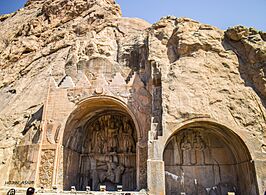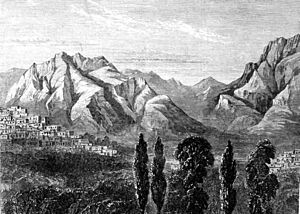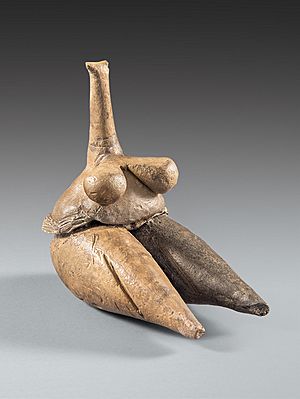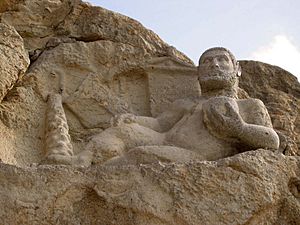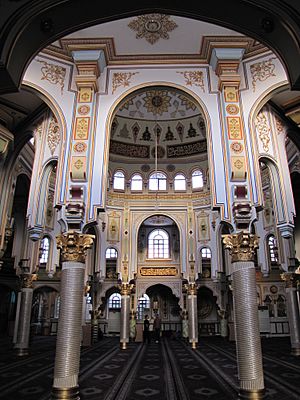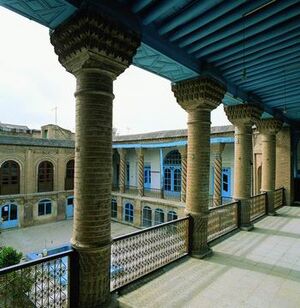Kermanshah facts for kids
Quick facts for kids
Kermanshah
کرمانشاه;
|
||
|---|---|---|
|
City
|
||
|
Panoramic, Takyeh Beyglarbeygi, Imad Doulah Mosque, Takyeh Moaven-ol-Molk (Tekiye Moaven Al Molk), Jameh Mosque of Shafei, Taq-e Bostan
|
||
|
||
| Nickname(s):
The Land of History & Myths; The Land of Eternal Lovers; The Land of Shirin & Farhad
|
||
| Country | Iran | |
| Province | Kermanshah | |
| County | Kermanshah | |
| District | Central | |
| Established date | 390 AD | |
| Elevation | 1,350 m (4,430 ft) | |
| Population
(2016)
|
||
| • Urban | 946,651 | |
| • Metro | 1,083,833 | |
| • Demonym | Kermashani Kermanshahi | |
| Time zone | UTC+3:30 (IRST) | |
| Postal code |
67146
|
|
| Area code(s) | 083 | |
| Climate | Csa | |
Kermanshah is a big city in western Iran. It's the capital of Kermanshah Province. The city is about 525 kilometers (326 miles) from Tehran, Iran's capital. In 2016, about 946,651 people lived there.
Contents
People and Language
Kermanshah is home to many people. In 2006, about 784,602 people lived in the city. By 2011, this number grew to 851,405.
Most people in Kermanshah speak South Kurdish. They can also speak standard Persian. A smaller group speaks a local dialect called Kermanshahi Persian. Kermanshah has the largest Kurdish population in Iran. Most people are Shia Muslims, but there are also Sunni Muslims, Christians, and followers of Yarsanism.
What's in a Name?
The name "Kermanshah" comes from an old title, Kirmanshah. This means "King of Kerman". Prince Bahram, the son of King Shapur III, got this title. He was made governor of the Kerman province. Later, in 390 AD, when he became King Bahram IV, he founded the city. The city was then named after his title, meaning "City of the King of Kirman".
A Look Back in Time: Kermanshah's History
Kermanshah is a very old city. It has beautiful landscapes and a rich culture. Because of this, it's seen as one of the places where early human cultures began.
Ancient Times
Archaeologists have found signs that people lived in the Kermanshah area for a very long time. This goes back to the Lower Paleolithic period. Stone tools like hand axes have been found.
Neanderthals also lived here. Their bones have been found in caves in Kermanshah province. Some famous caves are Warwasi and Do-Ashkaft Cave.
The area was also one of the first places where people settled down. Villages like Asiab and Ganj-Darreh were built 8,000 to 10,000 years ago. This was around the time the first pottery in Iran was made in Ganj-Darreh. In 2009, an even older village was found in Sahneh, west of Kermanshah. It dates back 9,800 years!
The city itself has four ancient mound sites. These show where villages used to be.
Sassanid Era
In old Iranian stories, the city was built by King Tahmuras. But it's believed the Sassanids built Kermanshah. King Bahram IV (who was called Kermanshah) gave his name to the city.
Kermanshah was a grand city during the Sassanid period (around the 4th century AD). It became a capital city and a summer retreat for Sassanid kings.
Islamic Era
Kermanshah was taken over by the Arabs in 629 AD. Later, under the Seljuks in the 11th century, it became a major cultural and trading hub in western Iran. The Mongols attacked it in 1257. The Safavids later made the city stronger. The Ottomans tried to take it over but were stopped by the Qajars.
Recent History
During World War I, the Imperial Russian army and then the Ottoman Army occupied Kermanshah. British forces arrived in 1917 and the Ottomans left. Kermanshah was important in Iran's Iranian Constitutional Revolution. The city was badly damaged during the Iran–Iraq War. It has been rebuilt, but it's still recovering.
Weather in Kermanshah
Kermanshah has a climate that is affected by the nearby Zagros mountains. It has hot summers and mild, wet winters. There's more rain here than in Tehran. Summers are very hot during the day. Winters are quite cold, and it usually snows for a few weeks.
The highest temperature ever recorded was 44.1°C (111.4°F) on July 13, 1998. The lowest was -27.0°C (-16.6°F) on February 6, 1974.
| Climate data for Kermanshah (1991–2020, extremes 1951-2020) | |||||||||||||
|---|---|---|---|---|---|---|---|---|---|---|---|---|---|
| Month | Jan | Feb | Mar | Apr | May | Jun | Jul | Aug | Sep | Oct | Nov | Dec | Year |
| Record high °C (°F) | 20.2 (68.4) |
21.8 (71.2) |
28.4 (83.1) |
33.7 (92.7) |
38.5 (101.3) |
43.0 (109.4) |
44.1 (111.4) |
44.0 (111.2) |
40.4 (104.7) |
34.4 (93.9) |
28.4 (83.1) |
25.4 (77.7) |
44.1 (111.4) |
| Mean daily maximum °C (°F) | 8.8 (47.8) |
11.3 (52.3) |
16.0 (60.8) |
21.3 (70.3) |
27.5 (81.5) |
34.9 (94.8) |
38.8 (101.8) |
38.6 (101.5) |
33.6 (92.5) |
26.2 (79.2) |
16.9 (62.4) |
11.5 (52.7) |
23.8 (74.8) |
| Daily mean °C (°F) | 2.6 (36.7) |
4.7 (40.5) |
9.0 (48.2) |
13.8 (56.8) |
19.1 (66.4) |
25.7 (78.3) |
29.4 (84.9) |
28.9 (84.0) |
23.7 (74.7) |
17.3 (63.1) |
9.5 (49.1) |
4.9 (40.8) |
15.7 (60.3) |
| Mean daily minimum °C (°F) | −2.9 (26.8) |
−1.5 (29.3) |
2.0 (35.6) |
6.1 (43.0) |
9.6 (49.3) |
13.9 (57.0) |
17.9 (64.2) |
17.4 (63.3) |
12.4 (54.3) |
8.3 (46.9) |
2.9 (37.2) |
−1.0 (30.2) |
7.1 (44.8) |
| Record low °C (°F) | −24.0 (−11.2) |
−27.0 (−16.6) |
−11.3 (11.7) |
−6.1 (21.0) |
−1.0 (30.2) |
2.0 (35.6) |
8.0 (46.4) |
8.0 (46.4) |
1.2 (34.2) |
−3.5 (25.7) |
−17.0 (1.4) |
−17.0 (1.4) |
−27.0 (−16.6) |
| Average precipitation mm (inches) | 57.1 (2.25) |
56.0 (2.20) |
68.4 (2.69) |
59.0 (2.32) |
25.5 (1.00) |
1.0 (0.04) |
0.9 (0.04) |
0.3 (0.01) |
2.6 (0.10) |
32.9 (1.30) |
61.1 (2.41) |
51.6 (2.03) |
416.4 (16.39) |
| Average precipitation days (≥ 1.0 mm) | 7.7 | 7.2 | 7.6 | 7.4 | 4 | 0.3 | 0.2 | 0.1 | 0.3 | 3 | 5.7 | 6.6 | 50.1 |
| Average rainy days | 7.9 | 8.8 | 9.5 | 9.9 | 5.3 | 0.5 | 0.3 | 0.2 | 0.6 | 5.2 | 9.1 | 9 | 66.3 |
| Average snowy days | 5.4 | 4.0 | 1.8 | 0.2 | 0.0 | 0.0 | 0.0 | 0.0 | 0.0 | 0.0 | 0.3 | 2.6 | 14.3 |
| Average relative humidity (%) | 68 | 61 | 54 | 52 | 43 | 23 | 19 | 18 | 21 | 35 | 56 | 66 | 43 |
| Average dew point °C (°F) | −3.7 (25.3) |
−3.3 (26.1) |
−1.5 (29.3) |
2.5 (36.5) |
3.8 (38.8) |
0.8 (33.4) |
1.4 (34.5) |
0.5 (32.9) |
−2.0 (28.4) |
−0.8 (30.6) |
−0.3 (31.5) |
−2.0 (28.4) |
−0.4 (31.3) |
| Mean monthly sunshine hours | 154 | 160 | 198 | 216 | 272 | 339 | 341 | 338 | 303 | 245 | 186 | 158 | 2,910 |
| Source 1: NCEI | |||||||||||||
| Source 2: Iran Meteorological Organization (snow/sleet days 1951-2010, (records) | |||||||||||||
Cool Places to See
Kermanshah has many interesting places to visit. These include ancient bridges, rock carvings, temples, and historical houses.
Taq-e Bostan: Rock Carvings

Taghbostan is a collection of large rock carvings. They were made during the Sassanid Empire (226 to 650 AD). These carvings are about 5 kilometers (3 miles) from Kermanshah city. They are in the Zagros Mountains.
These carvings are some of the best examples of Sassanid art. They show kings like Ardashir II and Shapur III. The carvings highlight power, honor, and the joy of the Sassanid kings.
The Sassanid kings chose a beautiful spot for these carvings. It was along an old Silk Road route. There's also a sacred spring nearby that flows into a pool at the base of the mountain.
One impressive carving is inside the largest cave, or ivan. It shows King Khosrow II (591-628 AD) on his horse, Shabdiz. Both the horse and rider are in full battle armor. The arch around the carving has beautiful patterns of the tree of life. Above the arch, there are two winged angels.
Behistun Inscription: An Ancient Code
Behistun Inscription is a UNESCO World Heritage Site. It's a huge inscription carved into Mount Behistun. The name Bagastana means "the god's place".
This inscription has the same text written in three different ancient languages: Old Persian, Elamite, and Babylonian. It was like an ancient "Rosetta Stone" for cuneiform writing. It helped experts understand these lost writing systems.
The inscription is about 15 meters (49 feet) high and 25 meters (82 feet) wide. It's 100 meters (328 feet) up a cliff! It was made hard to reach so it would be more visible after it was finished. The carving shows Darius holding a bow. His foot is on a figure lying down, who is believed to be a pretender named Gaumata. There are also ten other figures representing conquered peoples.
Qajar Dynasty Buildings
During the Qajar dynasty (1794 to 1925), many beautiful buildings were made in Kermanshah. These include the Kermanshah Bazaar, mosques, and special religious buildings called tekyehs.
Tekyeh Biglarbeygi is famous for its amazing mirror decorations. Tekyeh Moaven al-molk is special because its walls have many pictures. Some show stories from the shahnameh (a famous Persian epic poem).
Khajeh Barookh's House is in an old part of the city. It was built by a Jewish merchant named Barookh. This house shows traditional Iranian architecture. It has an inner courtyard and private bathrooms, which were rare for its time.
Bazaars: Shopping Centers of the Past
Kermanshah has at least one old bazaar from the Qajar period. The Kermanshah Grand Bazaar (also called Tarike Bazaar) was built around 1820. It was once the largest grand bazaar in the Middle East.
Churches
- Sacred Heart of Jesus Church
Kermanshah's Economy
Kermanshah is a major farming area in western Iran. It grows grains, rice, vegetables, fruits, and oilseeds. It's also becoming an important industrial city. There are over 256 factories nearby. These include oil refineries, textile factories, food processing plants, and carpet making.
The Kermanshah Oil Refining Company (KORC) started in 1932. It's one of the city's biggest industries. Kermanshah is also a key place for importing and exporting goods in Iran.
Learning in Kermanshah
Kermanshah has many universities and schools. Over 49,000 students study in 9 universities.
Universities
The Kermanshah University of Medical Sciences was the first university in western Iran. It started in 1968 as a nursing school. Razi University opened in 1972. It's the most important higher education place in Kermanshah province. In 2020, Razi University was ranked 24th in Iran.
Some universities in Kermanshah are:
- Islamic Azad University of Kermanshah
- Kermanshah University of Medical Sciences
- Kermanshah University of Technology
- Payame Noor University
- Razi University
Schools
Mohtashamiyeh was the first modern school in Kermanshah. It opened in 1899. Khalq Study Hall was the first study hall and adult school, founded in 1909. The first girls' school, Azodiyeh State School for Misses, opened in 1922. The first private school in Kermanshah started in 1991.
Famous People from Kermanshah
Many talented people come from Kermanshah in arts, music, science, and sports.
Arts
- Ali Mohammad Afghani, novelist
- Seyed Khalil Alinezhad, Tanbour master
- Mahshid Amirshahi, writer
- Ali Ashraf Darvishian, novelist
- Pouran Derakhshandeh, film director
- Reza Shafiei Jam, actor
- Mirza Mohammad Reza Kalhor, calligrapher
- Mir Jalaleddin Kazzazi, writer
- Rahim Moeini Kermanshahi, poet
- Alexis Kouros, writer and filmmaker
- Abolghasem Lahouti, poet
- Doris Lessing, writer and Nobel Prize winner (born in Kermanshah)
- Aref Lorestani, actor, comedian
- Shahram Mokri, film director
- Nicky Nodjoumi, painter
- Reza Fieze Norouzi, actor
- Guity Novin, painter & graphic designer
- Mohammad Salemy, artist
- Rashid Yasemi, famous Persian Literature scholar
Music
- Evin Agassi, singer
- Kayhan Kalhor, musician
- Mojtaba Mirzadeh, violin and setar master
- Roknoddin Mokhtari, violin player
- Ali Akbar Moradi, musician
- Shahram Nazeri, vocalist
- Sohrab Pournazeri, musician
- Sousan (Golandam Taherkhani), singer
- Marganita Vogt-Khofri, pianist
- Bahramji, musician
Sciences
- Shahram Amiri, nuclear scientist
- Massoud Azarnoush, archaeologist
- Al-Dinawari, botanist, historian, geographer
- Fereidoun Biglari, archaeologist
Sports
- Makwan Amirkhani, mixed martial artist
- Kourosh Bagheri, world weightlifting champion
- Homa Hosseini, rower
- Ali Mazaheri, boxer
- Mohammad Hassan Mohebbi, freestyle wrestler
- Mohammad Hossein Mohebbi, freestyle wrestler
- Yadollah Mohebbi, freestyle wrestler
- Mohammad Ranjbar, former football player and coach
- Kianoush Rostami, world weight lifting champion
- Neda Shahsavari, table tennis champion
- Mohammad Torkashvand, volleyball champion
- Mehran Shahintab, Basketball champion and coach
- Peter Warr, racing driver
- Saeid Ahmadi, karate champion
- Seyyedmasoud Derekeh, kickboxing champion
Images for kids
See also
 In Spanish: Kermanshah para niños
In Spanish: Kermanshah para niños







